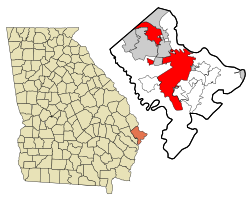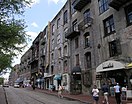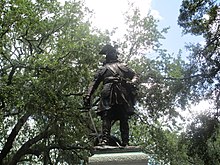Savannah, Georgia
From Wikipedia, the free encyclopedia
This article is about a city in the U.S. state of Georgia. For other uses of Savannah, see Savannah (disambiguation).
| Savannah, Georgia | |||||||||||
|---|---|---|---|---|---|---|---|---|---|---|---|
| City | |||||||||||
| City of Savannah | |||||||||||
Clockwise from top: downtown Savannah viewed from Bay Street, Forsyth Park, River Street, Talmadge Memorial Bridge with the Port of Savannah on theSavannah River, Savannah Victorian Historic District,Savannah College of Art and Design, Cathedral of St. John the Baptist, Congregation Mickve Israel, Savannah Historic District,
| |||||||||||
| |||||||||||
| Nickname(s): "The Hostess City of the South" | |||||||||||
 Location in Chatham County and the state of Georgia | |||||||||||
| Location in the United States | |||||||||||
| Coordinates: 32°1′N 81°7′WCoordinates: 32°1′N 81°7′W | |||||||||||
| Country | United States | ||||||||||
| State | Georgia | ||||||||||
| County | Chatham | ||||||||||
| Government | |||||||||||
| • Mayor | Edna Branch Jackson | ||||||||||
| • City Manager | Stephanie Cutter (Acting) | ||||||||||
| Area | |||||||||||
| • City | 108.7 sq mi (281.5 km2) | ||||||||||
| • Land | 103.1 sq mi (267.1 km2) | ||||||||||
| • Water | 5.6 sq mi (14.4 km2) | ||||||||||
| Elevation | 49 ft (15 m) | ||||||||||
| Population (est. 2014) | |||||||||||
| • City | 144,352 | ||||||||||
| • Density | 1,321.2/sq mi (510.1/km2) | ||||||||||
| • Metro | 372,708 | ||||||||||
| • Demonym | Savannahian | ||||||||||
| Time zone | EST (UTC−5) | ||||||||||
| • Summer (DST) | EDT (UTC−4) | ||||||||||
| ZIP codes | 31401-31499 | ||||||||||
| Area code(s) | 912 | ||||||||||
| FIPS code | 13-69000[1] | ||||||||||
| GNIS feature ID | 0322590[2] | ||||||||||
| Website | SavannahGA.gov | ||||||||||
Savannah is the oldest city in the U.S. state of Georgia and is the county seat of Chatham County. Established in 1733, the city of Savannah became the Britishcolonial capital of the Province of Georgia and later the first state capital of Georgia.[3] A strategic port city in the American Revolution and during the American Civil War,[4] Savannah is today an industrial center and an important Atlantic seaport. It is Georgia's fifth-largest city and third-largest metropolitan area.
Each year Savannah attracts millions of visitors to its cobblestone streets, parks, and notable historic buildings: the birthplace of Juliette Gordon Low (founder of theGirl Scouts of the United States of America), the Georgia Historical Society (the oldest continually operating historical society in the South), the Telfair Academy of Arts and Sciences (one of the South's first public museums), the First African Baptist Church (one of the oldest African-American Baptist congregations in the United States), Temple Mickve Israel (the third oldest synagogue in America), and the Central of Georgia Railway roundhouse complex (the oldest standing antebellum rail facility in America).[3][5]
Savannah's downtown area, which includes the Savannah Historic District, the Savannah Victorian Historic District, and 22 parklike squares, is one of the largestNational Historic Landmark Districts in the United States (designated by the U.S. government in 1966).[3][a] Downtown Savannah largely retains the original town plan prescribed by founder James Oglethorpe (a design now known as the Oglethorpe Plan). Savannah was the host city for the sailing competitions during the 1996 Summer Olympics held in Atlanta.
Contents
[hide]History[edit]
Main articles: History of Savannah, Georgia and Timeline of Savannah, Georgia
On February 12, 1733,[6] General James Oglethorpe and settlers from the ship Anne landed at Yamacraw Bluff and were greeted by Tomochichi, the Yamacraws, and Indian traders John and Mary Musgrove. Mary Musgrove often served as an interpreter. The city of Savannah was founded on that date, along with the colony of Georgia. In 1751, Savannah and the rest of Georgia became a Royal Colony and Savannah was made the colonial capital of Georgia.[7] By the outbreak of theAmerican Revolutionary War, Savannah had become the southernmost commercial port of the Thirteen Colonies. British troops took the city in 1778, and the following year a combined force of American and French soldiers failed to rout the British at the Siege of Savannah. The British did not leave the city until July 1782.[8]Savannah, a prosperous seaport throughout the nineteenth century, was the Confederacy's sixth most populous city and the prime objective of General William T. Sherman's March to the Sea. Early on December 21, 1864, local authorities negotiated a peaceful surrender to save Savannah from destruction, and Union troops marched into the city at dawn.[9]
Savannah was named for the Savannah River, which probably derives from variant names for the Shawnee, a Native American people who migrated to the river in the 1680s. The Shawnee destroyed another Native people, the Westo, and occupied their lands at the head of the Savannah River's navigation on the fall line, near present-day Augusta.[10] These Shawnee were known by several local variants, including Shawano, Savano, Savana and Savannah.[11] Another theory is that the name Savannah refers to the extensive marshlands surrounding the river for miles inland, and is derived from the English term "savanna", a kind of tropical grassland, which was borrowed by the English from Spanish sabana and used in the Southern Colonies. (The Spanish word comes from the Taino word zabana.)[12] Still other theories suggest that the name Savannah originates from Algonquian terms meaning "southerner" or perhaps "salt".[13][14]
Geography[edit]
Savannah lies on the Savannah River, approximately 20 mi (32 km) upriver from the Atlantic Ocean.[15] According to the United States Census Bureau (2011), the city has a total area of 108.7 square miles (281.5 km2), of which 103.1 square miles (267.0 km2) is land and 5.6 square miles (15 km2) is water (5.15%). Savannah is the primary port on the Savannah River and the largest port in the state of Georgia. It is also located near the U.S. Intracoastal Waterway. Georgia's Ogeechee Riverflows toward the Atlantic Ocean some 16 miles (26 km) south of downtown Savannah.
Savannah is prone to flooding. Five canals and several pumping stations have been built to help reduce the effects: Fell Street Canal, Pipe Makers Canal, Kayton Canal, Springfield Canal and Casey Canal, the first four draining north into the Savannah River and the last, the Casey, draining south into the Vernon River.
Climate[edit]
Savannah's climate is classified as humid subtropical (Köppen Cfa). In the Deep South this climate is characterized by long and almost tropical summers, with temperatures reaching freezing on only 24 days in the winter (and with rare snowfall). Due to its proximity to the Atlantic coast, Savannah rarely experiences temperatures as extreme as those in Georgia's interior. Nevertheless, the extreme temperatures have officially ranged from 105 °F (41 °C), as recently as July 20, 1986, down to 3 °F (−16 °C), on January 21, 1985.[16]
Summers tend to be humid with many thunderstorms. Nearly half of Savannah's precipitation falls during the months of June through September, characteristic of monsoon-type climates. Dewpoint in summer ranges from 67.8 °F (20 °C) to 71.6 °F (22 °C).[17] As the city is south of the snow line, it rarely receives snow in winter. Occasional Arctic cold fronts in winter can push nighttime temperatures as low as 20 °F (−7 °C), but rarely further than that.[17][18] Savannah straddles two recognized plant-hardiness zones: 8b, which is no colder than 15 °F (−9 °C), and 9a, no colder than 20 °F (−7 °C).[6]
Savannah is at risk for hurricanes, particularly of the Cape Verde type. Because of its location in the Georgia Bight (the arc of the Atlantic coastline in Georgia and northern Florida) as well as the tendency for hurricanes to re-curve up the coast, Savannah has a lower risk of hurricanes than some other coastal cities such as Charleston, South Carolina. Savannah was seldom affected by hurricanes during the 20th century, with one exception being Hurricane David in 1979. However, the historical record shows that the city was frequently affected during the second half of the 19th century. The most prominent of these storms was the 1893 Sea Islands hurricane, which killed at least 2,000 people. (This estimate may be low, as deaths among the many impoverished rural African-Americansliving on Georgia's barrier islands may not have been reported.)
| [show]Climate data for Savannah, Georgia (Savannah/Hilton Head Int'l), 1981–2010 normals, extremes 1871–present[b] |
|---|
The first meteorological observations in Savannah probably occurred at Oglethorpe Barracks circa 1827, continuing intermittently until 1850 and resuming in 1866. The Signal Service began observations in 1874, and the National Weather Service has kept records of most data continually since then; since 1948, Savannah-Hilton Head International Airport has served as Savannah's official meteorological station. Annual records (dating back to 1950) from the airport's weather station are available on the web.[22]
Urban[edit]
Neighborhoods[edit]
Savannah is a city of diverse neighborhoods. More than 100 distinct neighborhoods can be identified in six principal areas of the city: Downtown (Landmark Historic District and Victorian District), Midtown, Southside, Eastside, Westside, and Southwest/West Chatham (recently annexed suburban neighborhoods).
Historic districts[edit]
Besides the Savannah Historic District, one of the nation's largest, four other historic districts have been formally demarcated:[23]
- Victorian District
- Cuyler-Brownsville District
- Mid-City (Thomas Square) District
- Pin Point Historic District

















No comments:
Post a Comment